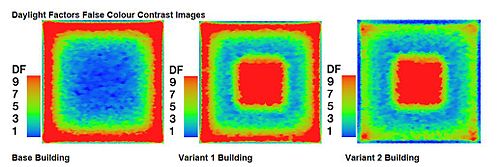- Daylight factor
-
A daylight factor is the ratio of internal light level to external light level and is defined as follows:
- DF = (Ei / Eo) x 100%
where, Ei = illumiance due to daylight at a point on the indoors working plane, Eo = simultaneous outdoor illuminance on a horizontal plane from an unobstructed hemisphere of overcast sky.
In order to calculate Ei, one must establish the amount of light received from the outside to the inside of a building. There are three paths along which light can reach a point inside a room through a glazed window, rooflight, or aperture, as follows:
- Direct light from a patch of sky visible at the point considered, known as the sky component (SC),
- Light reflected from an exterior surface and then reaching the point considered, known as the externally reflected component (ERC),
- Light entering through the window but reaching the point only after reflection from an internal surface, known as the internally reflected component (IRC).
The sum of the three components gives the illuminance level (lux) at the point considered:
- Lux = SC + ERC + IRC
Daylight factors are used in architecture and building design in order to assess the internal natural lighting levels as perceived on the working plane or surface in question, in order to determine if they will be sufficient for the occupants of the space to carry out their normal duties. The design day used for daylight factor calculations is based upon the Standard CIE overcast Sky for 21st September at 12:00pm, and where the Ground Ambient light level is 11921 Lux. CIE being the Commission Internationale de l´Eclairage, or International Commission on Illumination.
Calculating daylight factors requires complex repetition of calculations and thus is general undertaken by a proprietary computer software product such as Radiance. This is a suite of tools for performing lighting simulation which includes a renderer as well as many other tools for measuring the simulated light levels. It uses ray tracing to perform all lighting calculations.
In order to assess the effect of a poor or good daylight factor, one might choose to compare the results for a given calculation against published design guidance. In the UK this is likely to be CIBSE Lighting Guide 10 (LG10-1999) which broadly bands average daylight factors into the following categories:[1]
- Under 2 – Not adequately lit – artificial lighting will be required.
- Between 2 and 5 – Adequately lit but artificial lighting may be in use for part of the time.
- Over 5 – Well lit – artificial lighting generally not required except at dawn and dusk – but glare and solar gain may cause problems.
See also
Notes
- ^ CIBSE Lighting Guide 10: Daylighting and window design, Year: 1999, ISBN: 0900953985, Publisher: CIBSE
External links
Categories:
Wikimedia Foundation. 2010.

